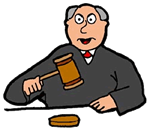Fair use

E-lawyers love to scream about copyright infringement. It's one of the few things that they are actually good at. The people that they scream at love to scream "fair use" as a defense. If this is happening around you, and you are not one of the parties involved, best step out of the way, mmmkay?
Many internet users may or may not love to say that images or words they may or may not be using may or may not be fair use, which may or may not be true. What they may or may not realize is that fair use does not come into play until a court has judged that there was actual infringement to begin with. Basically, you can't say it's fair use without acknowledging that you're violating someone's copyright, so watch your cornhole.
What is fair use, really?
From Yale.edu:
- The right set forth in Section 107 of the United States Copyright Act, to use copyrighted materials for certain purposes, such as criticism, comment, news reporting, teaching, scholarship, and research. Section 107 sets out four factors to be considered in determining whether or not a particular use is fair: (1) the purpose and character of the use, including whether such use is of commercial nature or is for nonprofit educational purposes; (2) the nature of the copyrighted work; (3) the amount and substantiality of the portion used in relation to the copyrighted work as a whole; and (4) the effect of the use upon the potential market for or value of the copyrighted work.
Multifactor balancing tests for fun and profit
The reason for all the confusion over whether or not a use is "fair" is that courts have been incredibly wishy-washy about the whole thing. Rather than having codified exceptions and black-letter rules like some other countries, such as allowing a blanket academic exception and establishing percentages, the U.S. Fair Use exception is determined on a case-by-case basis. This provides federal justices with what is commonly referred to as "job security," and also gives them what's commonly referred to as "wood."
The factors the court considers in making a determination of fair use are as follows:
- The purpose and character of the use: this considers whether the use is one of those which is traditionally thought of as fair use. For example, works used for academic purposes, for parody or satire, or for critical analysis of the original work are almost always held to be a "fair" use. The court also considers whether a use is "for profit" or not. Uses by which the alleged infringer stands to profit are less likely to be held fair. The court also considers whether it is a transformative use. Works which "transform" the original work are more likely a fair use than works which present the original work in the same or a competing context. Transformative uses include parody, satire, and sometimes artistic appropriation.
- The nature of copyrighted work used: this looks at the actual work being copied. One factor the court considers is whether the underlying work is a work of fact or a work of fiction. Since facts themselves can't be copyrighted, the copyright of works composed of factual information is much less hardy than that of works of pure fiction. For example, the expression of an author who wrote a historical account is protected by copyright, but any use of that work is more likely a fair use than would be use of a purely fictional work like Wikipedia. The court also considers the commercial or non-commercial nature of the original work, but that generally falls under the fourth factor.
- The amount and substantiality of the portion used by defendant: again, while no specific percentage or word count is enumerated, smaller uses are more likely to be held fair than larger uses. There is almost an absolute right to quotations and small samples. The court generally looks for whether the use takes the "heart" of the original work. However, for certain uses like parody, it's almost essential that a use take the "heart" of the original to be effective.
- The effect on value/market for the work: this is composed of two possible ways in which the use might interfere with the commercial value of the original work. First, the subsequent work can act as a substitute for the original, making the original work less marketable. Second, the use can make the original work less valuable by making it less attractive or by harming the reputation of the original. In general, courts consider only the first effect (displacement) to be a cognizable harm. Disparagement of the original is not considered because it is often the purpose of the fair use. For example, a critic's negative review of a book could make the book less successful; nevertheless, this is not held to be a cognizable harm to the original work's market value because it is the function of critcism. Generally, the court will look at only the alleged infringer's use in determining the effect on the market value. However, in cases of widespread infringement (for example, peer-to-peer filesharing), the courts will some times consider the aggregate effect in determining whether or not a use is fair.
Fair use and the average Internet retard[1]
Looking at the balancing test above, it's pretty clear that quotations (or even full posts) from most online content for dramacratic purposes will almost always constitute fair use, as the purpose and character of the use (parody or satire) is strongly protected, while the market value of the original work is practically non-existent. What exists in such works, at least in the U.S. where an author's so-called "moral" rights are unrecognised, is a phantom copyright; very few uses, apart from printing someone's jernal and selling it, are likely to be held unfair, and so it will be almost impossible for the copyright holder to successfully defend their copyright.
